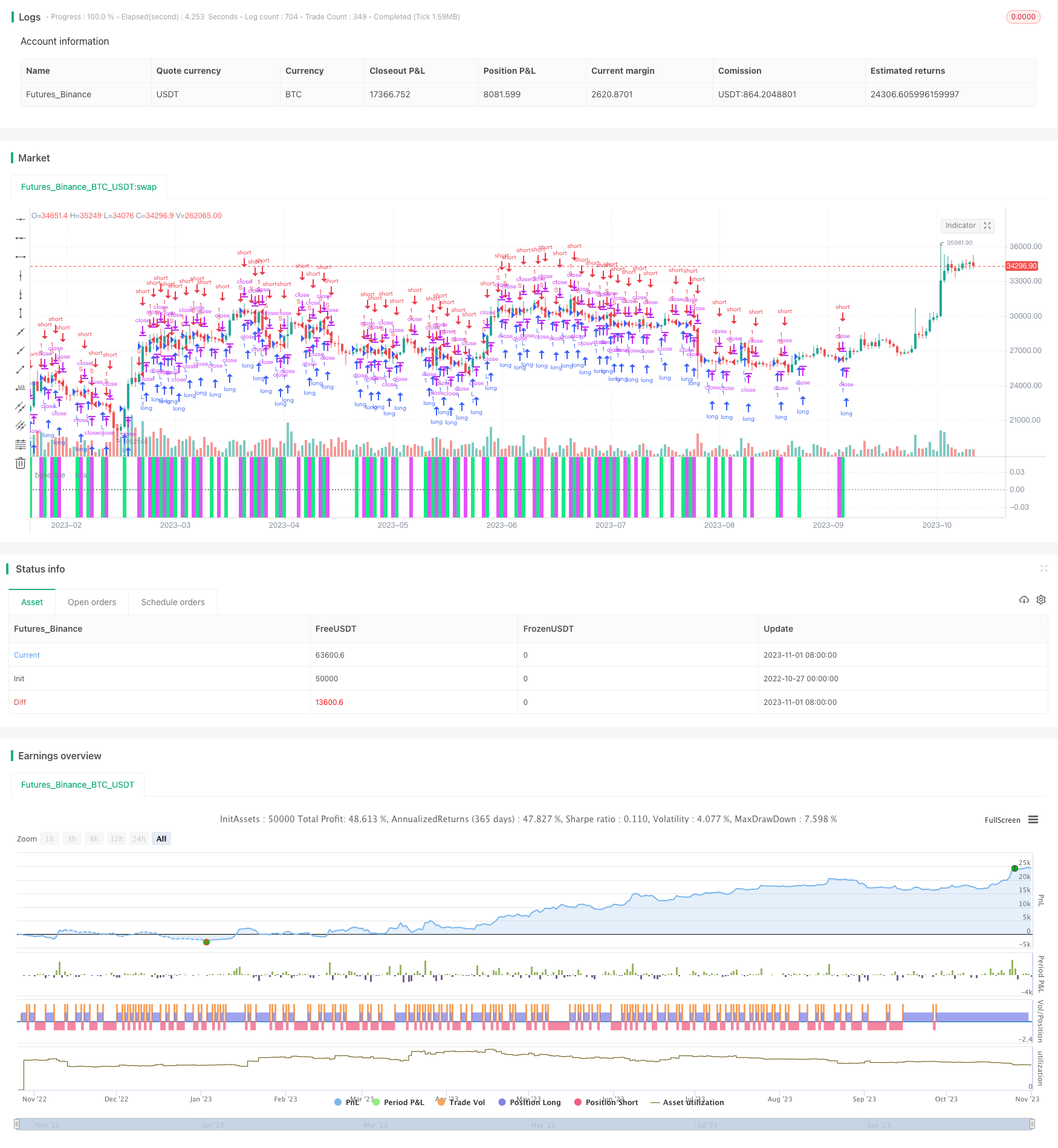
Overview
This strategy is based on the Karobein Mean Reversion indicator and price momentum. It uses price momentum auxiliary indicators for trend judgment and combines the Karobein Mean Reversion indicator for specific entry. This strategy is suitable for medium and long term trading.
Strategy Principle
Firstly, the strategy calculates the rate of change of prices at different periods to obtain the price momentum indicator. When the price momentum indicator crosses above the dynamic threshold line, a long signal is generated. When it crosses below, a short signal is generated.
Then it combines the Karobein Mean Reversion indicator to determine the specific entry timing. The Karobein Mean Reversion indicator is calculated based on the mean reversion nature of prices, which can reflect the acceleration and path of price fluctuations. This indicator has an intrinsic sinusoidal characteristic that helps determine the direction and timing of the trend.
When the price momentum indicator generates a signal, if the Karobein Mean Reversion indicator is in the corresponding directional area, an entry signal is generated.
Advantages
The strategy comprehensively considers price momentum and mean reversion factors, with strong trend judgment capability.
The Karobein Mean Reversion indicator can accurately locate price turning points and improve entry timing accuracy.
The holding period can be freely controlled by parameter adjustment, suitable for different time frames.
The dynamic threshold can be adjusted in real time for adaptive response to market changes.
Risks
As a trend following strategy, it is prone to being trapped in range-bound trends.
The Karobein Mean Reversion indicator has a certain lag, which may miss price turning points.
The holding period parameter should be monitored to avoid expanding losses from excessive holding periods.
The dynamic threshold should be set appropriately not too wide, otherwise entry opportunities may be missed.
Corresponding risk management methods:
Trend judgment indicators can be used to foresee ranging markets and exit positions in time.
Choose reasonable lags for the Karobein Mean Reversion indicator to reduce delays.
Test different holding period parameters and choose suitable ones.
Adjust the dynamic threshold range to avoid missing entries.
Enhancement Directions
Test different periods for price momentum calculation to optimize parameters.
Add volatility indicators to detect ranging markets and set stop loss.
Optimize parameters of the Karobein Mean Reversion indicator to make it more sensitive.
Add additional filters like volume to improve signal quality.
Use machine learning algorithms to dynamically optimize parameters.
Conclusion
This strategy comprehensively utilizes price momentum and mean reversion factors, with strong capabilities in trend judgment and signal generation. It can adapt to different market environments through parameter tuning. Further optimizations can be done regarding entry timing and stop loss to make the strategy more robust. This strategy deserves further research and application.
/*backtest
start: 2022-10-27 00:00:00
end: 2023-11-02 00:00:00
period: 1d
basePeriod: 1h
exchanges: [{"eid":"Futures_Binance","currency":"BTC_USDT"}]
*/
//@version=4
// author: capissimo
strategy("Normalized Vector Strategy, ver.3 (sc)", precision=2, overlay=false)
// This is a scaled Normalized Vector Strategy with a Karobein Oscillator
// original: Drkhodakarami (https://www.tradingview.com/script/Fxv2xFWe-Normalized-Vector-Strategy-By-Drkhodakarami-Opensource/)
// Repainting: in general there two types of repainting:
// * when the last candle is constantly being redrawn
// * when the indicator draws a different configuration after it has been deactivated/reactivated, i.e. refreshed
// The former is a natural behaviour, which presents a constant source of frustration,
// when a signal directly depends on the current market situation and can be overcome
// with various indirect techniques like divergence.
// The latter suggests a flaw in the indicator design.
// Unfortunately, the Normalized Vector Strategy is repainting in the latter sense, although being
// really promising. Would be nice if our community suggests a solution to this problem ))
// This strat consistently performs with high accuracy, showing up to 96% scores
// Here are some of the best parameters:
// TF Lookback Performance (ca.)
// 1m 13 92%
// 3m 34 92%
// 5m 85 92%
// 15m 210 90%
// 30m 360 89%
// 1H 1440,720 94%, 87%
// The Karobein Oscillator has an intrinsic sinusoidal behaviour that helps in determining direction and timing.
// It does not repaint.
// original: alexgrover (https://www.tradingview.com/script/JiNi0f62-Karobein-Oscillator/)
scaleMinimax(X, p, min, max) =>
hi = highest(X, p), lo = lowest(X, p)
(max - min) * (X - lo)/(hi - lo) + min
price = input(close, "Price Data")
tf = input(34, "Timeframe", minval=1, maxval=1440)
thresh = input(14., "Threshold", minval=.1, step=.1)
div = input(1000000,"Divisor", options=[1,10,100,1000,10000,100000,1000000,10000000,100000000])
showVol = input(false, "Volume")
useold = input(true, "Use Old System")
lime = color.new(color.lime, 10), fuchsia = color.new(color.fuchsia, 10),
black = color.new(color.black, 100), gray = color.new(color.gray, 50)
vol = useold ? security(syminfo.tickerid, tostring(tf), volume, barmerge.gaps_off, barmerge.lookahead_on)
: security(syminfo.tickerid, tostring(tf), volume)
obv = cum(change(price) > 0 ? vol : change(price) < 0 ? -vol : 0*vol)
prix = showVol ? obv : price
getdiff(prc, tf) =>
prev = useold ? security(syminfo.tickerid, tostring(tf), prc[1], barmerge.gaps_off, barmerge.lookahead_on) :
security(syminfo.tickerid, tostring(tf), prc[1])
curr = useold ? security(syminfo.tickerid, tostring(tf), prc, barmerge.gaps_off, barmerge.lookahead_on) :
security(syminfo.tickerid, tostring(tf), prc)
(curr/prev) - 1
p = getdiff(prix, tf)
up = thresh/div, dn = -thresh/div
longCondition = crossover(p, up)
shortCondition = crossunder(p, dn)
bg = longCondition ? lime : shortCondition ? fuchsia : black
cl = p > up ? color.green : p < dn ? color.red : color.silver
bgcolor(bg, editable=false)
plot(scaleMinimax(up, 2500, -1, 1), color=lime, editable=false, transp=0)
hline(0, linestyle=hline.style_dotted, title="base line", color=gray, editable=false)
plot(scaleMinimax(dn, 2500, -1, 1), color=fuchsia, editable=false, transp=0)
plot(scaleMinimax(p, 2500, -1, 1), color=cl, style=plot.style_histogram, transp=70, editable=false)
plot(scaleMinimax(p, 2500, -1, 1), color=cl, style=plot.style_linebr, title="prediction", transp=0, editable=false)
strategy.entry("L", true, 1, when=longCondition)
strategy.entry("S", false, 1, when=shortCondition)
alertcondition(longCondition, title='Long', message='Long Signal!')
alertcondition(shortCondition, title='Short', message='Short Signal!')
//*** Karobein Oscillator
per = input(8, "Karobein Osc Lookback")
prix2 = ema(price, per)
a = ema(prix2 < prix2[1] ? prix2/prix2[1] : 0, per)
b = ema(prix2 > prix2[1] ? prix2/prix2[1] : 0, per)
c = (prix2/prix2[1])/(prix2/prix2[1] + b)
d = 2*((prix2/prix2[1])/(prix2/prix2[1] + c*a)) - 1
plot(scaleMinimax(d, 2500, -1, 1), color=color.orange, transp=0)